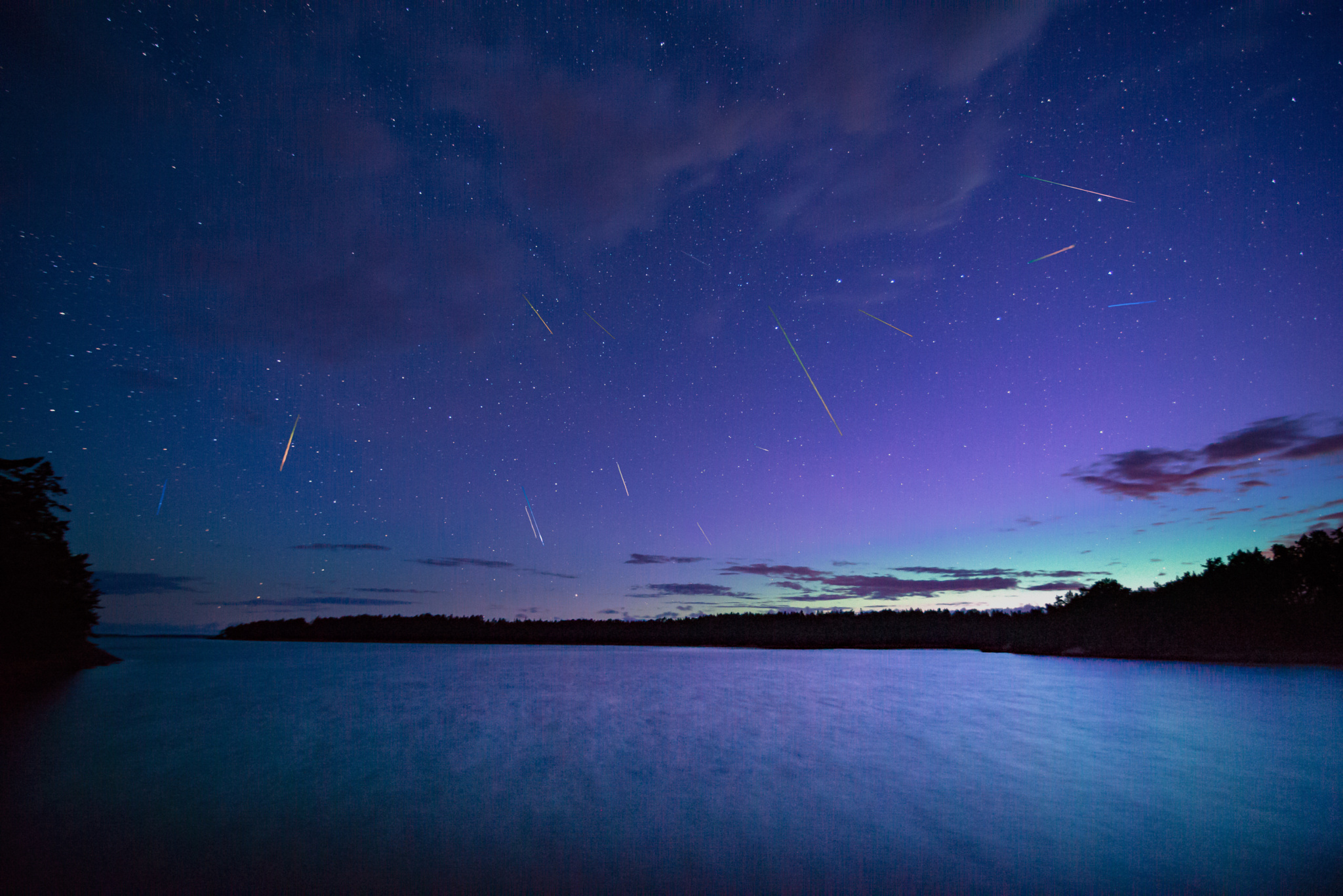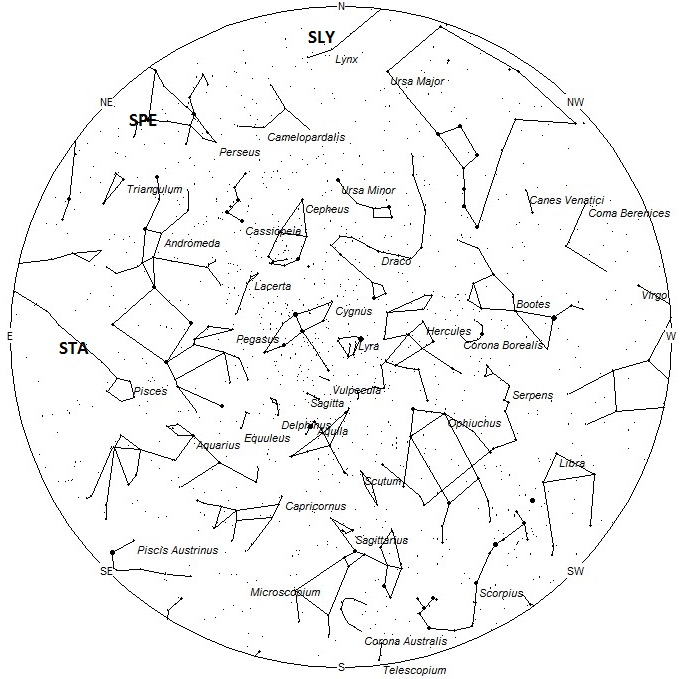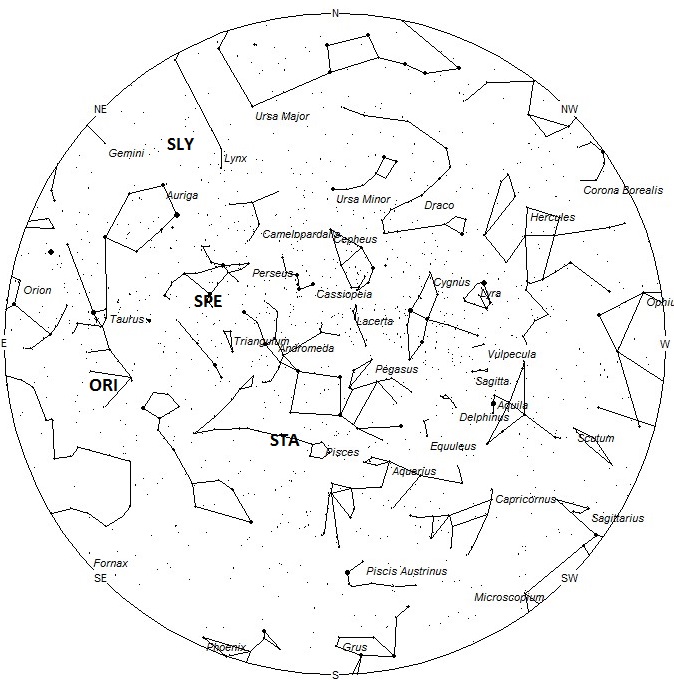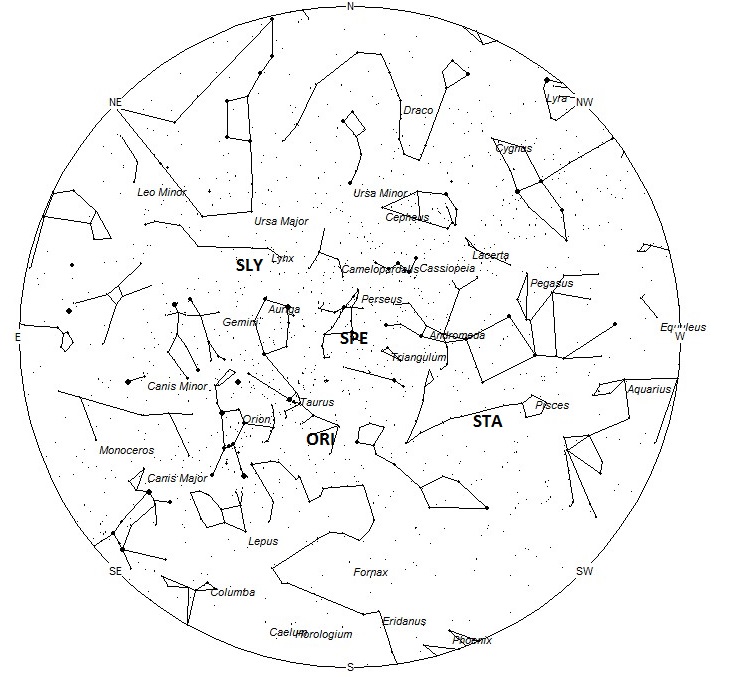
Composite Photo of Perseids meteors (2015) – a total of 600 shots and about 15 meteors of every size and colour. © Valentino Valkaj – Photography tours and workshops @ www.valentinovalkaj.com/tours
During this period the moon reaches its last quarter phase on Saturday September 5th. The half-illuminated moon will rise around 1:00 for viewers in mid-northern latitudes. While not ruining viewing conditions, the moon will still be a nuisance and should be avoided while viewing meteor activity. With each passing night the moon will become less of a problem as it rises later and wanes to a slender crescent phase. The estimated total hourly meteor rates for evening observers this week is near 4 as seen from mid-northern latitudes (45N) and 3 as seen from tropical southern locations (25S). For morning observers the estimated total hourly rates should be near 13 as seen from mid-northern latitudes (45N) and 10 as seen from tropical southern locations (25S). The actual rates will also depend on factors such as personal light and motion perception, local weather conditions, alertness and experience in watching meteor activity. Morning rates are reduced during this period by lunar glare. Note that the hourly rates listed below are estimates as viewed from dark sky sites away from urban light sources. Observers viewing from urban areas will see less activity as only the brightest meteors will be visible from such locations.
The radiant (the area of the sky where meteors appear to shoot from) positions and rates listed below are exact for Saturday night/Sunday morning September 5/6. These positions do not change greatly day to day so the listed coordinates may be used during this entire period. Most star atlases (available at science stores and planetariums) will provide maps with grid lines of the celestial coordinates so that you may find out exactly where these positions are located in the sky. A planisphere or computer planetarium program is also useful in showing the sky at any time of night on any date of the year. Activity from each radiant is best seen when it is positioned highest in the sky, either due north or south along the meridian, depending on your latitude. It must be remembered that meteor activity is rarely seen at the radiant position. Rather they shoot outwards from the radiant so it is best to center your field of view so that the radiant lies at the edge and not the center. Viewing there will allow you to easily trace the path of each meteor back to the radiant (if it is a shower member) or in another direction if it is a sporadic. Meteor activity is not seen from radiants that are located below the horizon. The positions below are listed in a west to east manner in order of right ascension (celestial longitude). The positions listed first are located further west therefore are accessible earlier in the night while those listed further down the list rise later in the night.
These sources of meteoric activity are expected to be active this week.
We are now encountering debris from comet 2P/Encke, which has a radiant superimposed upon the anthelion radiant. Since it has been shown that meteors from 2P/Encke are more numerous we shall recognize this activity as the Southern Taurids (STA) until December 5th, when the Earth no longer encounters these particles. The maximum was once thought to occur in early November when the radiant was located in Taurus. Video studies have shown that the peak usually occurs near October 10th but that there is also a period of enhancement during the last week of October and the first week of November, when the Northern Taurids are also active. The center of the large radiant is currently located at 00:20 (005) +03. This position lies in southern Pisces, seven degrees south of the fourth magnitude star Delta Piscium. These meteors may be seen all night long but the radiant is best placed near 0200 local daylight time (LDT) when it lies on the meridian and is located highest in the sky. Rates at this time should be near 2 per hour regardless of your location. With an entry velocity of 29 km/sec., the average Southern Taurid meteor would be of slow velocity.
The September Epsilon Perseids (SPE) peak on the night of September 9/10 from a radiant located at 03:12 (048) +40. This position lies in southwestern Perseus, very close to the famous eclipsing variable star known as Algol (Beta Persei). The radiant is best placed near 0500 LDT, when it lies highest above the horizon. Rates are expected to be near three per hour at maximum activity with the radiant located high in the sky. Less activity will be seen before midnight. These meteors are visible from the tropical regions of the southern hemisphere, but further south the radiant becomes too low in the sky to produce much activity. With an entry velocity of 66 km/sec., most activity from this radiant would be swift.
You may be surprised to see the Orionids (ORI) as an active radiant this time of year, but there is clear evidence from the IMO database that this shower is active long before its October 22nd maximum. In fact it is in the top four most active radiants throughout September. Expected rates this week are near 2 per hour no matter your location. This radiant is currently located at 04:08 (062) +04, which places it in southwestern Taurus, some twelve degrees southwest of the bright orange first magnitude star known as Aldebaran (Alpha Tauri). This area of the sky is best placed in the sky during the last hour before dawn, when it lies highest above the horizon in a dark sky. With an entry velocity of 67 km/sec., most activity from this radiant would be of swift speed.
Video studies by Molau and Rendtel has revealed a radiant active from September 7th-18th, with maximum activity occurring on the 10th. The radiant position on the 10th for the September Lyncids (SLY) is 06:22 (108) +56. This position lies in extreme northwestern Lynx some twelve degrees northeast of the second magnitude star known as Menkalinan (Beta Aurigae). This area of the sky is best placed in the sky during the last hour before dawn, when it lies highest above the horizon in a dark sky. Even at maximum activity hourly rates of only one are expected to be seen from the northern hemisphere. Due to the high northern declination this activity is not well seen south of the equator. With an entry velocity of 60 km/sec., most activity from this radiant would be of swift speed.
As seen from the mid-northern hemisphere (45N) one would expect to see approximately 8 sporadic meteors per hour during the last hour before dawn as seen from rural observing sites. Evening rates would be near 3 per hour. As seen from the tropical southern latitudes (25S), morning rates would be near 6 per hour as seen from rural observing sites and 2 per hour during the evening hours. Locations between these two extremes would see activity between the listed figures.
The table below presents a list of radiants that are expected to be active this week. Rates and positions are exact for Saturday night/Sunday morning except where noted in the shower descriptions.
| SHOWER | DATE OF MAXIMUM ACTIVITY | CELESTIAL POSITION | ENTRY VELOCITY | CULMINATION | HOURLY RATE | CLASS |
| RA (RA in Deg.) DEC | Km/Sec | Local Daylight Saving Time | North-South | |||
| Southern Taurids (STA) | Oct 10 | 00:20 (005) +03 | 29 | 02:00 | 2 – 2 | II |
| September Epsilon Perseids (SPE) | Sep 10 | 03:12 (048) +40 | 66 | 05:00 | 1 – <1 | II |
| Orionids (ORI) | Oct 22 | 04:08 (062) +04 | 67 | 06:00 | 2 – 2 | I |
| September Lyncids (SLY) | Sep 10 | 06:22 (108) +56 | 60 | 08:00 | <1 – <1 | IV |
 American Meteor Society
American Meteor Society



Hi,
I’ve been seeing a lot of hysterical messages on my Facebook feed about an impact with Earth and a comet in and around Sept 15th. Why is this happening? Is there any scientific proof of a large celestial body coming close to Earth?
Thanks
IW
Ian and All,
Hardly a year goes by without a dire prediction of a catastrophic collision between the Earth and a comet or asteroid. Like all those other predictions, this one is false no matter what you read on the internet.
Robert Lunsford
It’s nonsense. One of the stories I read about it said, “as Jesus predicted”. As a former Catholic I know Jesus never made such a prediction.
Hello, I saw the biggest and brightest meteor I’d ever seen the night of Sept 11th around 9 pm PST, in the southern hemisphere. There were no others that occurred in the 30 minutes prior, nor hour afterwards, that I could see with my naked eye. It seemed so close, I almost expected to “hear” it…. any record on what I saw…just curious.
Christine and All,
There does not seem to be any matches to your report in our fireball list you might try checking it to see if any new reports are received.
http://www.amsmeteors.org/members/imo_view/browse_events?country=-1&year=2015
Robert Lunsford